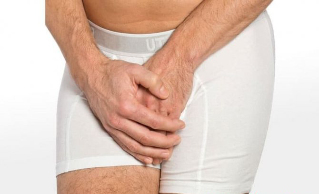
Prostatitis in men is an inflammation of the male prostate. It is a relatively common condition in men that is accompanied by pain when emptying the bladder (urination) and ejaculation. Doctors distinguish between acute and chronic prostatitis. Therapy and prognosis depend on the form and causes of prostate inflammation. Read all about prostatitis here.
Prostatitis: description
Prostatitis (inflammation of the prostate) is an inflammation of the human prostate. The prostate is located just below the bladder and is the size of a chestnut. It surrounds the first part of the urethra and extends to the so-called pelvic floor, which is made up of musculature.
The prostate produces a secretion that includes PSA (prostate-specific antigen) and spermine. PSA makes the ejaculate thinner. Sperm is important for sperm motility.
Prostatitis is mainly associated with severe pain in the perineum and anal area. In addition, symptoms such as frequency of urination, pain when urinating (urination) and pain during ejaculation occur during prostate inflammation.
The prostate is relatively common with inflammation. It is estimated that about 15 percent of all men in Germany develop prostatitis once in a lifetime. The likelihood of prostate infection increases with age. Research shows that most cases are between the ages of 40 and 50.
Prostatitis syndrome
At the same time, an expanded understanding of the term prostatitis has emerged in medicine. In the so-called prostatitis syndrome, several complaints are collected in the pelvic area of a person, which usually have an unknown cause. The term "prostatitis syndrome" summarizes the different clinical pictures:
- Acute bacterial prostatitis
- Chronic bacterial prostatitis
- Inflammatory and non-inflammatory chronic pelvic pain syndrome ("Abacterial chronic prostatitis")
- Asymptomatic prostatitis
Acute and chronic bacterial prostatitis
Acute prostatitis is caused by bacteria (acute bacterial prostatitis). Bacteria travel through the bloodstream to the prostate or spread from a bacterial infection of the bladder or urethra to the prostate. Acute prostatitis is usually a severe general condition with severe pain during urination, fever and chills. Inflammation of the prostate is caused by bacteria in about ten percent of cases.
Chronic prostatitis can develop from acute: if the inflammation of the prostate and recurrent microbes in the urine, the so-called prostate express (obtained by massaging the prostate fluid) or in the ejaculate, are observed for more than three months, then it is chronic inflammation. bacterial prostatitis. It is less rapid than acute prostatitis. Although chronic inflammation of the prostate causes pain when urinating and a possible feeling of pressure in the perineal region, the symptoms are usually not as severe as in acute prostatitis.
Chronic pelvic pain syndrome (abacterial prostatitis)
In most cases of prostate infection, bacteria cannot be detected in urine, prostate or ejaculate as the cause of the disease. The trigger for prostatitis remains unclear. Doctors call this syndrome chronic pelvic pain (chronic abacterial prostatitis).
However, in such cases, white blood cells (leukocytes) can often be found as an expression of prostate inflammation (chronic pelvic pain syndrome). In contrast, it is another form of the disease in which neither bacteria nor leukocytes are found (syndrome of non-inflammatory chronic pelvic pain). In general, chronic pelvic pain syndrome (abacterial prostatitis) is the most common form of prostatitis.
Asymptomatic prostatitis
In rare cases, asymptomatic prostatitis occurs. In this form of prostatitis, although there are signs of inflammation, there is no pain or other symptoms. Asymptomatic prostatitis is usually detected by chance, for example, as part of a fertility study.
Prostatitis: symptoms
Inflammation of the prostate can cause various symptoms of prostatitis. Although the symptoms of acute prostatitis can be very serious and cause severe discomfort, in chronic prostatitis they are usually somewhat milder. Not every affected person necessarily has all of these symptoms, and the severity of the symptoms can vary from person to person.
Acute prostatitis: symptoms
Acute prostatitis is often an acute condition in which patients suffer from fever and chills. Inflammation of the prostate, which surrounds the urethra, also causes typical urinary symptoms. Urination causes burning pain (alguria), and urine flow is significantly reduced (dysuria) due to swelling of the prostate. Because victims can only excrete small amounts of urine, they have a constant frequency of urination and have to go to the toilet frequently (pollakisuria). Other symptoms of prostatitis include pain in the bladder, pelvis and back. Pain can also occur during or after ejaculation.
Chronic prostatitis: symptoms
Chronic prostatitis usually causes less severe symptoms than acute prostatitis. Symptoms such as fever and chills are usually completely absent. Symptoms such as a feeling of pressure in the perineum or lower abdomen, darkening of the ejaculate due to blood in the semen or blood in the urine (hematuria) are typical of chronic inflammation of the prostate. Disorders of sex drive and potency are also common chronic symptoms, often due to pain during or after ejaculation. The symptoms of chronic bacterial and chronic abacterial prostatitis (chronic pelvic pain syndrome) do not differ.
How to recognize?

The onset of prostatitis is rarely recognized unambiguously, as it is sometimes asymptomatic, and its symptoms are individual to each patient and change over time.
These features include:
- A man has little difficulty passing urine to the toilet. The gland gradually expands, the urethra shrinks
- The patient loses interest in sex. Difficulties with penis arousal increase when attempting sexual contact. Orgasm is achieved by difficulty, or weak, or disappears completely.
- Burning in the urethra, itching in the perineum.
- I often want to urinate, but I realize it drop by drop.
- The seed comes out quickly during intercourse with minimal satisfaction.
- General fatigue, depression, irritability, aggression, increased anxiety.
In the morning the person feels overcrowded, loses initiative in life.
At the same time, erections and painful ejaculation sometimes prolong spontaneously at night and are not related to sex.
Observing these phenomena, the patient calms down, believing that he is good with potency, the problems are, in his opinion, related to the partner, their relationship. Depression prevailed, which worsened the development of the disease.
Incidence statistics
Prostatitis is one of the most common diseases of the male genitourinary system in the world. According to various sources, it is observed in 60-80% of sexually mature men. According to official medical statistics, over 30% of young people of reproductive age suffer from chronic prostatitis. In approximately one third of cases, it occurs in men older than 20 years and under 40 years. According to the WHO, urologists diagnose chronic prostatitis in every tenth patient.
Complications of prostatitis
In addition to acute symptoms, prostatitis can lead to complications that complicate the course of the disease and prolong the treatment period. The most common complication is prostate abscess (especially in acute bacterial prostatitis). Prostate abscess is a purulent inflammation of the inflammation that usually needs to be opened and emptied by incision.
As a further complication of prostate inflammation, the inflammation can spread to nearby structures such as the epididymis or testicles (epididymitis, orchitis). Chronic prostatitis is also suspected to be associated with the development of prostate cancer.
Prostatitis: causes and risk factors
Prostatitis can have different causes. Treatment and prognosis of inflammation depend on the cause of prostatitis.
Bacterial prostatitis: causes
Only ten percent of prostatitis cases are caused by bacteria from the prostate (bacterial prostatitis). Bacteria can enter the prostate through the blood (hematogenous) or from nearby organs such as the bladder or urethra, where they can cause an inflammatory reaction.
Escherichia coli (E. coli), which occurs primarily in the human intestine, is the most common cause of prostatitis. Klebsiella, enterococci or mycobacteria can also cause prostatitis. Bacterial prostatitis can also be caused by sexually transmitted diseases, such as chlamydial or trichomoniasis, and gonorrhea.
In chronic prostatitis, the bacteria in the prostate have avoided the still unclear way of protecting the human immune system. This allows the microbes to constantly colonize the prostate. Antibiotics are relatively poor in prostate tissue, which may be another reason for bacteria to survive in the prostate.
Chronic pelvic pain syndrome: causes
The exact causes of chronic pelvic pain syndrome have not yet been fully elucidated. Scientists have put forward many theories, each of which sounds convincing, but all of them have not yet been clearly proven. In some cases, genetic material from previously unknown microorganisms was found in the small pelvis. Therefore, the cause of pelvic pain syndrome may be microorganisms that cannot yet be grown in the laboratory and, therefore, have not been detected.
Another possible cause of chronic pelvic pain syndrome is impaired bladder emptying. Due to the violation of drainage, the volume of the bladder increases, which puts pressure on the prostate. This pressure eventually damages the prostate tissue, causing inflammation.
Another possible cause is that inflammation of the bladder tissue can spread to the prostate.
It is also possible that irritation of the nerves around the prostate causes pain that is incorrectly attributed to the prostate.
Finally, it is also possible that an overactive or misdirected immune system causes chronic pelvic pain syndrome.
However, in many cases the cause of chronic pelvic pain cannot be clearly demonstrated. Then doctors talk about idiopathic prostatitis.
Anatomical reasons
In rare cases, prostatitis is caused by narrowing of the urethra. If the urethra narrows, urine accumulates and if it enters the prostate, it can also cause inflammation. This narrowing can be caused by tumors or so-called prostate stones.
Doctors also suspect that pelvic floor muscle dysfunction may contribute to the development of prostatitis.
Mental reasons
More and more psychological causes of prostatitis have been discussed lately. In particular, in non-inflammatory syndromes of chronic pelvic pain, psychological triggering is likely. The exact mechanisms are not yet known.
Risk factors for prostatitis

Some men are especially at risk of developing a prostate infection. These include, for example, men with a weakened immune system or a suppressed immune system (e. g. , with drugs, immunosuppressive therapy). In addition, underlying diseases such as diabetes can contribute to the development of prostatitis: high blood sugar in diabetics often leads to high urinary sugar. The abundance of sugar in the urine can provide good conditions for bacteria to grow, facilitating the development of urinary tract infections. In addition, the immune system is weakened in diabetes.
Another risk factor for developing prostatitis is a bladder catheter. Insertion of a catheter through the urethra can cause small tears in the urethra and damage to the prostate. In addition, as with any foreign body, bacteria can settle on the bladder and form a so-called biofilm. As a result, bacteria can travel through the urethra to the bladder and lead to prostate infection.
Prostatitis: examinations and diagnosis
In case of prostate problems, the family doctor or urologist is the right contact person. Your GP may take a medical history, but if prostatitis is suspected, they will refer you to a urologist. This performs a physical examination. If prostatitis is suspected, it is usually a so-called digital rectal examination. However, this study does not provide clear evidence of prostate inflammation, but only confirms the suspicion. Laboratory tests can be performed to detect bacterial prostatitis. If no specific cause is identified, treatment is also carried out in cases of reasonable suspicion of prostatitis.
Case history
Typical questions when recording a medical history may be:
- Do you have pain when urinating?
- Where exactly do you feel pain?
- Does your back hurt?
- Did you notice a change in ejaculation?
Digital rectal examination
Because the prostate is located next to the rectum, it can be palpated along the rectum. This digital rectal examination is performed on an outpatient basis and without anesthesia, and is usually painless. The patient is asked to lie down with his legs bent. Using a lubricant, the doctor slowly inserts a finger into the anus and scans the prostate and surrounding organs (palpation). It examines the size and sensitivity to prostate pain: an inflamed prostate is enlarged and very sensitive to pain.
Laboratory examination
Urine analysis is done in most cases to identify possible pathogens. The standard method is the so-called four-glass sample. Here, Ersturin, Mittelstrahlurin, Prostataexprimat and Urine are tested after prostate massage. As Prostateexprimat is called, doctors call it prostate secretion. This is accomplished by the physician by applying gentle pressure to the prostate, such as palpation. Ejaculate can be checked for both pathogens and signs of inflammation.
Further research
Ultrasound examination of the rectum (sonography) can be used to determine exactly where the inflammation is located and how far it has spread. An important goal of the study is to exclude other diseases with similar symptoms (differential diagnosis).
Urine flow measurement (uroflowmetry) is performed to rule out that an existing urinary drainage problem causes a narrowing of the urethra. The patient urinates in a special funnel, which measures the amount of urine per unit time. Normal urine flow is 15 to 50 milliliters per second, while urine flow is ten milliliters per second or less, there is a high probability of urethral obstruction.
Prostatitis: PSA measurement
Elevated levels of PSA in the blood (prostate specific antigen) are usually considered an indicator of prostate cancer. However, even with prostatitis, the level of PSA in the blood can increase significantly. If the reading is significantly elevated, tissue sampling (biopsy) is usually performed and examined in the laboratory to rule out prostate cancer.
Prostatitis: Treatment
As with other diseases, the treatment of prostatitis and the duration of treatment depend on the cause.
Drug
Acute bacterial prostatitis is treated with antibiotics. In mild cases, a dose of antibiotics is enough for ten days. For chronic prostatitis, the drug should be taken for a longer period of time (about four to six months). Even if the symptoms have already subsided, antibiotics should in any case be continued as prescribed by the doctor. This prevents relapse and reduces the likelihood of relapse.
Antibiotics can also treat asymptomatic prostatitis.
If there is chronic abacterial prostatitis (chronic pelvic pain syndrome), antibiotic therapy is usually ineffective. In chronic inflammatory pain syndrome, although there is no evidence of a pathogen, antibiotic testing is performed because it can sometimes improve. However, antibiotic therapy is not recommended for non-inflammatory chronic pelvic pain syndromes.
Other therapeutic approaches to chronic abacterial prostatitis are so-called 5α-reductase inhibitors and herbal medicines (herbal medicine). If no improvement is achieved, drug therapy will be supplemented with physiotherapy. She recommends physical therapy, pelvic floor exercises or regular prostate massage. In addition, microwave heat therapy can encourage tissues to increase blood flow and reduce pain.
In addition, symptomatic therapy may help alleviate the acute symptoms of a prostate infection. Pain relief can be prescribed for severe pain. Also, heating pads and heating pads on your back or lower abdomen can help you relax your muscles. It often relieves the pain of inflammation of the prostate.
Home remedies like processing rye or eating soft purified pumpkin seeds can also help with prostatitis symptoms. Other tips include regular pelvic floor exercises, without a sharp bike saddle and without beer, meat, fat and sugar.Treatment of complications
If massive urinary tract obstruction occurs in case of illness, prostatectomy may be helpful because residual urine always poses a high risk of urinary tract infection.
If the inflammation secretes pus in the prostate (abscess), it should be emptied with an incision. The access route is usually the rectum.
























